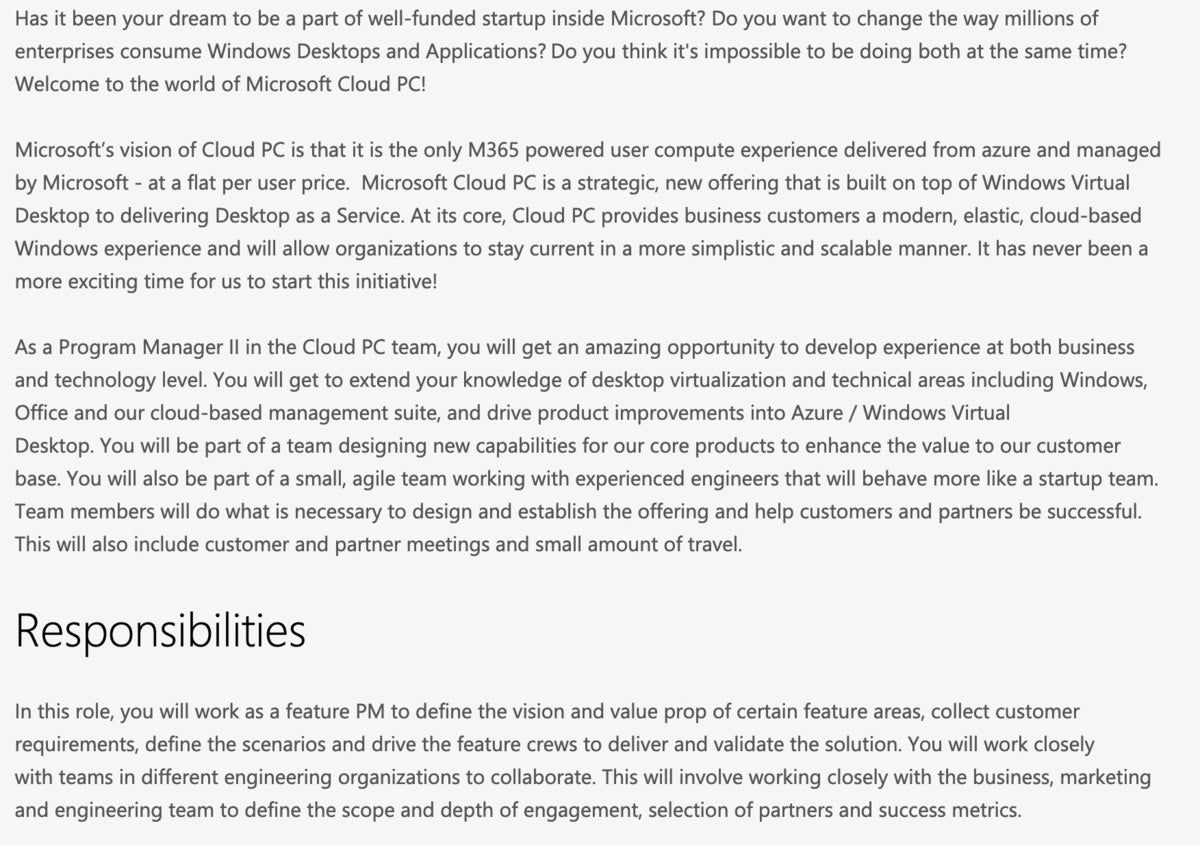Here comes Windows as a Desktop-as-a-Service: Microsoft Cloud PC.
Ready or not, here comes Windows as a Desktop-as-a-Service (DaaS) for all users in the forthcoming Microsoft Cloud PC offering.
I’ve been predicting that many of us would soon be using Desktop-as-a-Service for a long time now. I can give you an approximate date now. By May 2021, most of you will be able to run Windows from Microsoft’s Azure cloud using Cloud PC.
Of course, you’ve long been able to run Windows remotely. Citrix Systems, after all, starting back in 1989 made a multi-billion dollar business from offering just such services. Microsoft has been moving towards a subscription, Desktop-as-a-Service (DaaS) model for more four years. Recently, Microsoft released Microsoft 365 and Windows Virtual Desktop (WVD).
And, now recent leaks by well-regarded Microsoft leaker WalkingCat, shows us a new, broader Windows DaaS in the making: Cloud PC.
We knew Cloud PC was coming. As top Microsoft watcher Mary Jo Foley pointed out in July, Microsoft was looking for a program manager for Microsoft’s Cloud PC team. The job entailed creating Microsoft Cloud PC, a strategic, new offering built on top of Windows Virtual Desktop to deliver Desktop as a Service. “At its core, Cloud PC provides business customers a modern, elastic, cloud-based Windows experience and will allow organizations to stay current in a more simplistic and scalable manner.”
Microsoft
What’s different about Cloud PC from Windows Virtual Desktop from a user’s viewpoint is that instead of paying for it on an Azure cloud-usage basis, you’ll subscribe to it for a fixed rate. For many businesses — and pretty much all home users — being able to budget exactly for a subscription is much more attractive.
Microsoft will offer Medium, Heavy, and Advanced subscriptions. (Although there’s no hint of a “Light” offering, I expect there will be one.) I think the Light, or perhaps the “Beginner” package will come with a single virtual CPU, 4GB of RAM, and 48GB of SSD storage.
The Medium plan comes with two virtual CPUs, 4GB of RAM, and 96GB of SSD storage. It’s designed for “general-purpose [use] optimized for cost and flexibility.” With the Heavy plan, users get all the above, but they’ll have access to 8GB of RAM. It’s for users with “advanced compute needs optimized for performance and speed.”
Finally, there’s the Advanced plan. It includes 8GB of RAM, three virtual CPUs, and an unknown amount of SSD storage. It offers “accelerated graphics optimized for scalability and data processing.” Since fast graphics is what this release is all about, we can safely presume it will be built on top of Azure GPU workstations NVv4 Virtual Machines (VMs). These feature AMD EPYC 7002-series vCPUs with have frequencies of up to 3.3GHz. It’s also possible, however, that they’ll be built from other Azure desktop VMs using NVIDIA graphics.
And, now for that million-dollar question: “How much will they cost?” We don’t know yet.
Using the Azure VM Calculator, I came up with the following estimates using one-year Reserved Virtual Machine Instances: Medium: $64.71; Heavy: $129.42; and Advanced: $243.16. None of those price points look particularly attractive to me, so I suspect Microsoft will offer significant discounts for Cloud PC. So let’s say that puts Medium at $25; Heavy, $50; and Advanced, $100.
You’ll be able to run these instances on any system that can run the Microsoft Remote Desktop app. In the Microsoft family, that includes 32- and 64-bit Windows 10 on both x86 and Arm64; Windows 8.1; Windows Server 2019; Windows Server 2016; and Windows Server 2012 R2. You can also run it on macOS, iOS, and Android.
Yes, that’s right you’ll be able to run Cloud PC on your Mac, iPhone, or Android phone. There will be more. Today, you can access Microsoft Remote Desktop services on Chromebooks with Microsoft’s Remote Desktop 8. You can also run Microsoft Remote Desktop services on Linux desktops using a variety of Remote Desktop Protocol (RDP) clients such as Remmina, FreeRDP, and Vinagre.
I fully expect that Microsoft will fully and officially support both Chromebooks and Linux PCs by the time Cloud PC is commercially available. It only makes sense.
The bugs have long been worked out of RDP and the name of Microsoft’s business game these days is all about subscription services, not “selling” Windows and Office licenses. The broader Microsoft can make its market for Cloud PC, the better. Heck, I wouldn’t even be shocked if the company offered it on Windows 7, since nearly 10% of users are still running Windows 7, despite its security problems.
At least on Cloud PC, they’d be doing the bulk of their work on a safer platform.
So, what do you think? Can you see subscribing to Windows on the cloud? Or, will you stick with a traditional Windows PC? Before you decide, keep in mind that many of you, if I’d asked you five years ago if you’d still be using Office on your desktop or Office 365 on the cloud, you’d have said the PC.
Today, Office 365 is overwhelming more popular than Office 2016, and Office 2019 isn’t even on the charts. That points the way to how this should shake out.
This article originally appeared on ComputerWorld.


